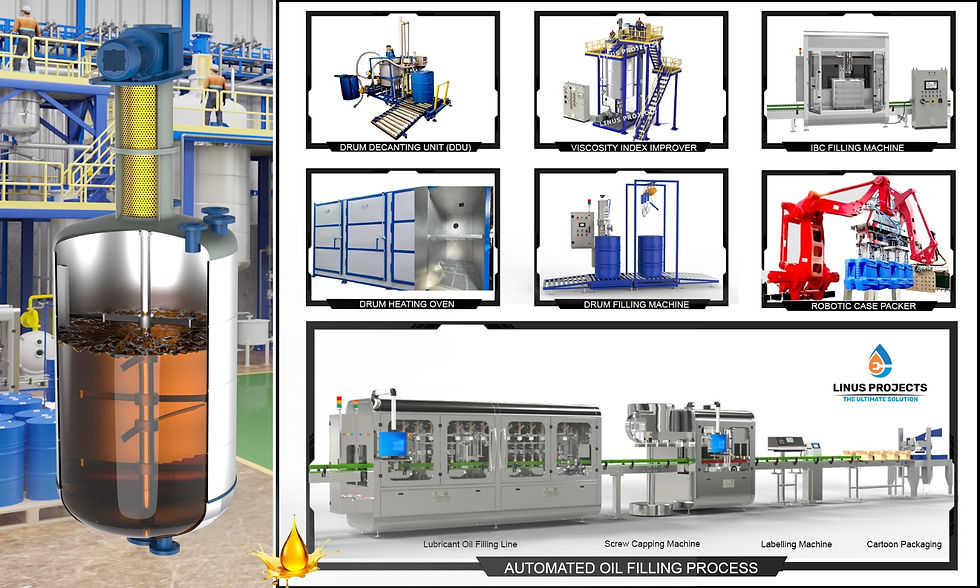Setting Up a Lube Oil Blending Plant
- LINUS PROJECTS

- Sep 21
- 4 min read
Updated: Sep 22
The establishment of an oil blending plant requires meticulous planning, technical knowledge, and adherence to industry standards. This process involves the integration of various components, including base oils, additives, and precise blending techniques, to produce high-quality lubricants. The objective is to create a facility capable of efficient production while maintaining product consistency and compliance with regulatory requirements. This article outlines the essential steps and considerations involved in setting up an oil blending plant, providing practical insights for businesses aiming to enter or expand within the lubricant manufacturing sector.
Key Considerations for Oil Blending Plant Setup
The setup of an oil blending plant involves several critical factors that influence operational efficiency and product quality. Initially, the selection of an appropriate location is paramount. The site should offer adequate space for storage tanks, blending equipment, and packaging lines, while also ensuring accessibility for raw material delivery and product distribution.
Next, the design of the plant layout must optimise workflow and safety. Segregation of raw material storage, blending, and packaging areas minimises contamination risks. Additionally, the installation of automated control systems enhances precision in blending ratios and reduces human error.
Equipment selection is another vital aspect. The plant requires blending tanks, mixing vessels, filtration units, and filling machines. Each component must be compatible with the types of lubricants produced and capable of handling the required production volume. Furthermore, compliance with environmental and safety regulations necessitates the inclusion of spill containment systems and proper ventilation.

Essential Steps in Oil Blending Plant Setup
The process of establishing an oil blending plant can be divided into several stages, each demanding careful execution:
Feasibility Study and Market Analysis
Conducting a detailed feasibility study helps identify market demand, potential clients, and competitive landscape. This analysis informs decisions regarding plant capacity and product range.
Design and Engineering
Collaborating with experienced engineers ensures the plant design meets production goals and safety standards. This phase includes drafting process flow diagrams and selecting appropriate machinery.
Procurement and Installation
Sourcing high-quality equipment from reputable manufacturers is crucial. Installation should be supervised by technical experts to guarantee proper assembly and calibration.
Quality Control Implementation
Establishing a laboratory for testing raw materials and finished products ensures adherence to specifications. Quality control protocols must be integrated into daily operations.
Training and Staffing
Recruiting skilled personnel and providing comprehensive training on equipment operation, safety procedures, and quality standards is essential for smooth plant functioning.
Commissioning and Trial Runs
Before full-scale production, trial runs validate the blending process and equipment performance. Adjustments are made based on test results to optimize output.
Regulatory Compliance and Certification
Obtaining necessary licenses and certifications from relevant authorities confirms the plant’s compliance with industry regulations.

What is the cost of lube oil blending plant in India?
The cost of establishing a lube oil blending plant in India varies significantly based on capacity, technology, and automation level. A small-scale plant with basic equipment may require an investment starting from INR 50 lakhs, while a fully automated, large-capacity facility can exceed INR 5 crores.
Key cost components include:
Land and Infrastructure: Expenses related to site acquisition, construction, and utilities.
Machinery and Equipment: Blending tanks, filtration systems, filling machines, and control panels.
Raw Materials: Initial stock of base oils and additives.
Labor and Training: Hiring skilled operators and technicians.
Regulatory and Licensing Fees: Costs associated with obtaining permits and certifications.
It is advisable to engage with turnkey project providers who offer comprehensive solutions, including design, procurement, installation, and commissioning. Such partnerships can optimize costs and reduce project timelines.

Operational Best Practices for Efficient Production
Once the plant is operational, maintaining efficiency and product quality requires adherence to best practices:
Regular Maintenance: Scheduled servicing of equipment prevents breakdowns and prolongs machinery life.
Inventory Management: Accurate tracking of raw materials and finished goods minimizes waste and stockouts.
Process Monitoring: Continuous monitoring of blending parameters ensures consistency.
Safety Protocols: Implementation of strict safety measures protects personnel and equipment.
Environmental Controls: Proper waste disposal and emission controls reduce environmental impact.
Automation and digital monitoring systems can further enhance operational control, enabling real-time adjustments and data-driven decision-making.
Future Trends in Oil Blending Plant Technology
The lubricant manufacturing industry is evolving with advancements in technology and increasing environmental regulations. Future oil blending plants are expected to incorporate:
Advanced Automation: Utilizing AI and IoT for predictive maintenance and enhancing process efficiency.
Sustainable Practices: Use of bio-based lubricants and energy-efficient equipment.
Modular Plant Designs: Flexible configurations that allow easy capacity expansion.
Enhanced Quality Control: Implementation of inline testing and real-time analytics.
Adopting these innovations will enable plants to meet growing market demands while minimizing operational costs and environmental footprint.
The establishment of a lube oil blending plant requires a strategic approach encompassing site selection, equipment procurement, and operational excellence. By following the outlined steps and embracing technological advancements, businesses can achieve efficient production and expand their market presence globally. LINUS PROJECTS (INDIA) offers turnkey solutions that facilitate this process, ensuring clients receive comprehensive support from project inception to commissioning.




Comments